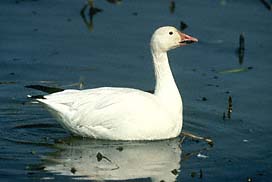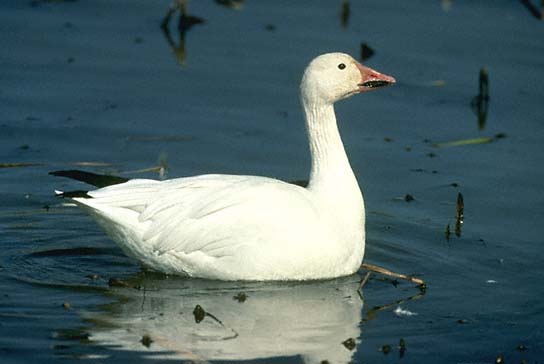Duck-like Birds
Description
25-31" (64-79 cm). Smaller than the domestic goose. Pure white with black wing tips; bill pink with black "lips"; legs pink. Young birds have dark bill and are mottled with brownish gray above. A dark phase, once considered a separate species called the "Blue Goose," has bluish-gray upperparts, brownish underparts, and white head and neck. Blue-phase birds have spread westward in recent decades and are now found locally throughout their winter range among the thousands of white Snow Geese.
Voice
A high-pitched, barking bow-wow! or howk-howk!
Habitat
Breeds on the tundra and winters in salt marshes and marshy coastal bays; less commonly in freshwater marshes and adjacent grainfields.
Nesting
4-8 white eggs in a nest sparsely lined with down on the tundra. Nests in colonies.
Range
Breeds in Arctic regions of North America and extreme eastern Siberia. In the West, winters on Pacific Coast from southern British Columbia south to Baja California; also mid-Atlantic Coast and Gulf Coast from Mississippi to Texas. In smaller numbers in interior.
Discussion
Snow Geese migrate long distances, sometimes flying so high that they can barely be seen. Even at this distance, however, they can often be identified by the shifting curved lines and arcs they form as they fly. Hunters call these birds "Wavies," but not because of the shape of their flocks; the word is derived from wewe, the Chippewa name for the species. In the Far North fresh plant shoots are scarce in early spring, but the geese arrive with good fat reserves, built up from plants consumed on prairie marshes where they pause during their long spring migration. Snow Geese graze fields and marshes of Pacific coastal areas and the Southwest all winter. The largest concentrations are in California's Central Valley and along the Gulf Coast of Texas and Louisiana. As they do elsewhere, these birds spend the night resting on open water.


